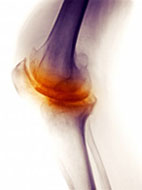|
Conditions & Treatments - Knee Osteoarthritis |
|

Knee osteoarthritis is the most
common form of arthritis in the geriatric population (1, 2).
Thirty-three percent of persons 63-94 years of age are affected
by knee osteoarthritis
(1, 2). Pain, impaired mobility, and reduced muscle
strength are common findings in patients with OA which can limit
activities of daily living (1, 2). Knee osteoarthritis is
primarily characterized by cartilage deterioration along with
associated ligament tearing, bone calcification and changes in
musculature that may cause joint space narrowing (2, 3). Changes
to the joint space can cause significant pain, muscle weakness,
joint instability and decreased range of motion for these
patients (3).
Last revised: June 9, 2011
|
References
1. Deyle GD, Henderson NE, Matekel RL, Ryder MG, Garber MB, Allison SC.
Effectiveness of manual physical therapy and exercise in osteoarthritis of
the knee. A randomized, controlled trial. Ann Intern Med. 2000 Feb
1;132(3):173-81.
2. Peat G, McCarney R, Croft P, Knee pain and osteoarthritis in older adults
a review of community burden and current use of primary health care. Ann
Rheum Dis. 2001;60:91-7.
3. Bennell KL, Hinman RS. A review of the clinical evidence for exercise in
osteoarthritis of the hip and knee. J Sci Med Sport. 2011 Jan;14(1):4-9.
4. Boissonnault, B., UW Madison joint pain lecture power point-OA ppt 1-50,
April, 2011.
5. Deyle GD, Allison SC, Matekel RL, Ryder MG, Stang JM, Gohdes DD, Hutton
JP, Henderson NE, Garber MB. Physical therapy treatment effectiveness for
osteoarthritis of the knee: a randomized comparison of supervised clinical
exercise and manual therapy procedures versus a home exercise program.
PhysTher. 2005 Dec;85(12):1301-17.
6. Abbott JH, Robertson MC, McKenzie JE, Baxter GD, Theis JC, Campbell AJ;
MOA Trial team. Exercise therapy, manual therapy, or both, for
osteoarthritis of the hip or knee: a factorial randomised controlled trial
protocol. Trials. 2009 Feb 8;10:11.
7. French H.P, Brennan A, White B, Cusack T, Manual Therapy for
osteoarthritis of the hip or knee-A systematic review. Manual Therapy 16
(2011) 109-117.
8. Falconer K, Hayers KW, Chang RW. Effect of ultrasound on mobility in
osteoarthritis of the knee: a randomized clinical trial. Arthritis care res.
1992;5:29-35.
|
|
|
|





